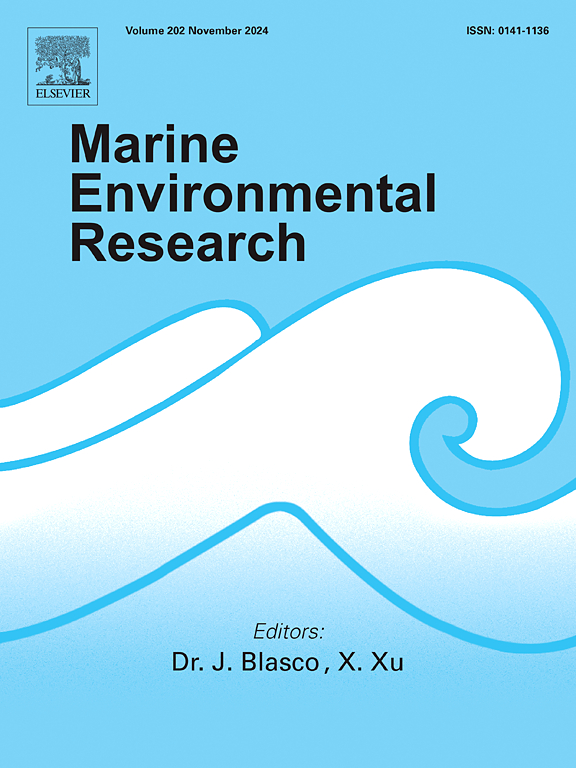PFAS-herbicide diflufenican reduces the photosynthetic capacity in seagrass (Zostera marina L.)
IF 3.2
3区 环境科学与生态学
Q2 ENVIRONMENTAL SCIENCES
引用次数: 0
Abstract
Global decline of seagrasses is directly linked with anthropogenic activities. One of the increasing threats, is marine pollution with a wide range of chemically synthesized substances. Here, we investigated effects of the commonly used PFAS-herbicide, diflufenican (DFF), on Zostera marina L. photobiology, over a 3-week exposure period, followed by 2-weeks of recovery. Measurements were conducted on seagrass leaves exposed to three different DFF concentrations (i.e., untreated, 0.015, 0.03 and 0.3 mg DFF L−1). Photosynthesis and respiration rates, as a function of increasing photon scalar irradiance, were determined with the use of optical sensors measuring net gas exchange. Variable chlorophyll fluorescence imaging was used for determining the 2D photosynthetic capacity of the seagrass leaves. Photopigment concentrations in the seagrass leaves were quantified using HPLC-analysis. We show that DFF reduced the photosynthesis rates for plants exposed to 0.03 and 0.3 mg DFF L−1 already after 1 week of exposure. While the imaging of photosynthetic capacity only showed a reduction for the highest DFF concentration (0.3 mg L−1) after 3 weeks. Concentrations of chlorophyll a, chlorophyll b and β-carotene generally increased with exposure time for all treatments. Yet, no signs of recovery from exposure to high DFF concentrations were observed in the plants’ photosynthetic capacity after 2 weeks. These findings indicate that exposure to high concentrations of DFF reduces the photosynthetic performance and capacity of seagrass (Z. marina L.), which over time and combined with other environmental stressors may cause synergetic negative effects that are detrimental to seagrasses.

pfas除草剂双氟虫尼降低海草(Zostera marina L.)光合能力
全球海草的减少与人类活动直接相关。其中一个日益严重的威胁,是海洋污染与广泛的化学合成物质。在这里,我们研究了常用的pfas除草剂双氟虫尼(DFF)对Zostera marina L.光生物学的影响,为期3周的暴露期,然后是2周的恢复期。对暴露于三种不同DFF浓度(即未处理、0.015、0.03和0.3 mg DFF L−1)的海草叶片进行了测量。利用测量净气体交换的光学传感器,测定了光合作用和呼吸速率作为光子标量辐照度增加的函数。采用可变叶绿素荧光成像技术测定海草叶片的二维光合能力。采用高效液相色谱法测定海草叶片中光色素的含量。我们发现,DFF在暴露于0.03和0.3 mg DFF L−1后1周,降低了植物的光合速率。而光合能力成像仅显示DFF最高浓度(0.3 mg L−1)在3周后下降。叶绿素a、叶绿素b和β-胡萝卜素的浓度随暴露时间的延长而增加。然而,暴露于高浓度DFF 2周后,植物的光合能力没有恢复的迹象。这些发现表明,暴露于高浓度的DFF会降低海草的光合性能和能力(Z. marina L.),随着时间的推移和其他环境胁迫因素的结合可能会产生对海草有害的协同负面影响。
本文章由计算机程序翻译,如有差异,请以英文原文为准。
求助全文
约1分钟内获得全文
求助全文
来源期刊

Marine environmental research
环境科学-毒理学
CiteScore
5.90
自引率
3.00%
发文量
217
审稿时长
46 days
期刊介绍:
Marine Environmental Research publishes original research papers on chemical, physical, and biological interactions in the oceans and coastal waters. The journal serves as a forum for new information on biology, chemistry, and toxicology and syntheses that advance understanding of marine environmental processes.
Submission of multidisciplinary studies is encouraged. Studies that utilize experimental approaches to clarify the roles of anthropogenic and natural causes of changes in marine ecosystems are especially welcome, as are those studies that represent new developments of a theoretical or conceptual aspect of marine science. All papers published in this journal are reviewed by qualified peers prior to acceptance and publication. Examples of topics considered to be appropriate for the journal include, but are not limited to, the following:
– The extent, persistence, and consequences of change and the recovery from such change in natural marine systems
– The biochemical, physiological, and ecological consequences of contaminants to marine organisms and ecosystems
– The biogeochemistry of naturally occurring and anthropogenic substances
– Models that describe and predict the above processes
– Monitoring studies, to the extent that their results provide new information on functional processes
– Methodological papers describing improved quantitative techniques for the marine sciences.
 求助内容:
求助内容: 应助结果提醒方式:
应助结果提醒方式:


